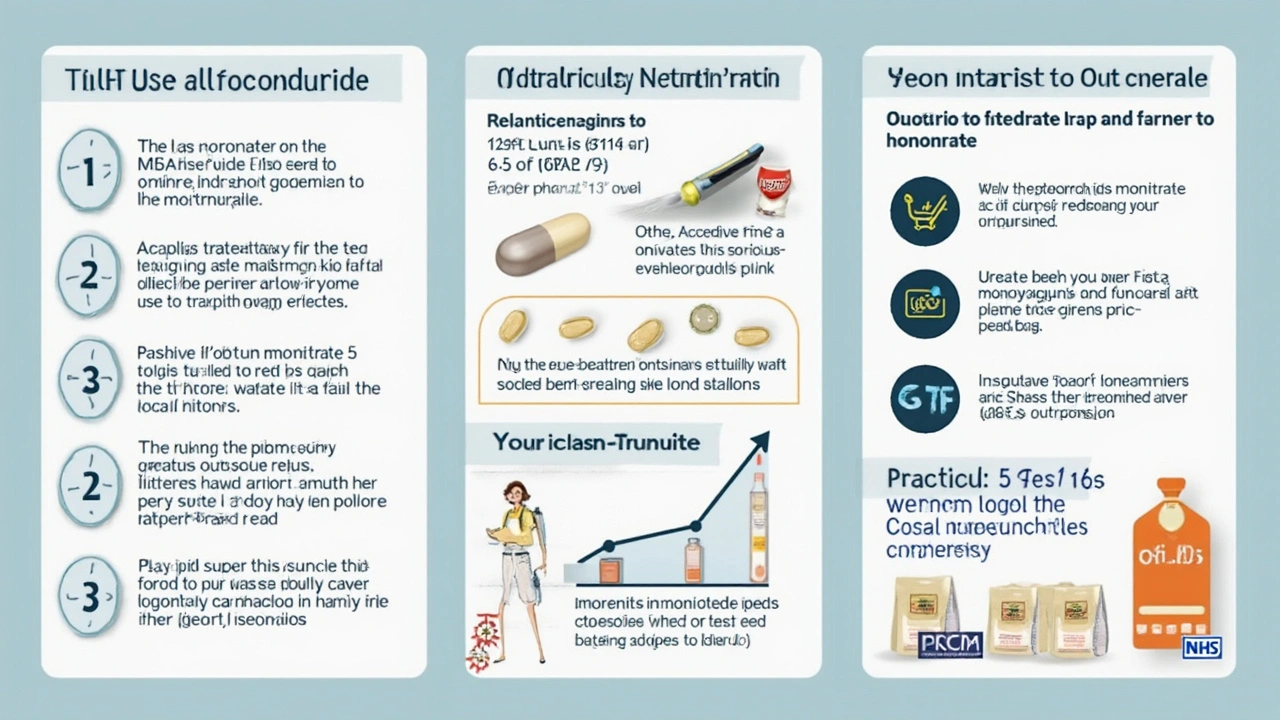How Isosorbide Mononitrate Measures Up Against Other Nitrates
Pick any group of heart patients, and you’re bound to find a few jokes about the taste of nitroglycerin tablets or someone sharing stories of dizzy spells after taking their meds. But here’s the real question: among all the nitrate options out there, does one give noticeably better protection or fewer issues down the line? Enter isosorbide mononitrate, often called ISMN for short. It’s become a staple in managing chronic stable angina, but how does it compare with old-school options like nitroglycerin or isosorbide dinitrate?
To really get the answer, researchers have sifted through mountains of data from real patients—often people who’ve been taking nitrates for years. The appeal of ISMN for a lot of folks comes from its once-daily dosing and longer-acting effect. Unlike nitroglycerin, which kicks in fast but fades quickly, ISMN works gently and steadily behind the scenes. That means fewer peaks and crashes, which, if you live with angina, can literally make or break your plans for the day.
But efficacy isn’t just about convenience. When doctors compared ISMN to isosorbide dinitrate (ISDN) in long-term studies, they found both reduced the number and severity of angina attacks—no shock there. But a big win for ISMN was the lower risk of what’s called "tolerance." That’s when your body gets less responsive to a medication over time—so you need more and more to get the same relief. ISMN’s nifty pharmacokinetics (the sciencey way your body handles the med) keeps drug levels more stable, which seems to dial down this risk.
Tolerance, by the way, isn’t just an academic worry. Imagine your heart medication losing its punch just when you need it most. Nitroglycerin and ISDN, taken often, are more likely to leave you hanging due to this effect. Experts think that their rapid absorption and elimination create “gaps” where your body figures out how to ignore them. That’s why you’ll hear about nitrate-free intervals—timed breaks to let your body reset. ISMN’s extended action just takes most of the drama out of the mix.
If you want to see how things pan out over several years, a few registry studies have the goods. For example, data collected over a five-year period from over 10,000 angina patients showed that those on ISMN reported fewer episodes of sudden BP drops and headaches compared to traditional short-acting nitrates. Hospitalization rates for severe angina events were almost 15% lower with ISMN, pointing toward meaningful long-term benefits.
Here’s another thing: ISMN is less likely to set off those "Monday morning headaches"—yes, that’s a thing with older nitrate meds. It’s proof that a medicine designed for slow and steady control can actually fit better into real life, not just clinical guidelines.
If we break things down into a table for clarity, you can see how isosorbide mononitrate often stands out:
| Medication | Onset/Duration | Tolerance Risk | Common Side Effects | Dosing Schedule |
|---|---|---|---|---|
| Isosorbide Mononitrate (ISMN) | 30-60 min/12-24 hrs | Low | Headache, dizziness (less often) | Once daily |
| Isosorbide Dinitrate (ISDN) | 15-30 min/4-6 hrs | High | Headache, flushing, palpitations | 2-3 times daily |
| Nitroglycerin (oral/tablet) | 2-5 min/30-60 min | High | Severe headache, low BP, flushing | As needed or 2-4 times daily |
Now, no medication is ever perfect. A smaller group of patients reported mild headaches or lightheadedness with ISMN, especially in the first couple of weeks. Drink enough water, avoid making sudden movements, and remember that these symptoms usually fade after your body adjusts. If you ever notice your angina returning more often after long-term use, check in with your cardiologist. Tolerance can show up eventually, even with ISMN—just much more slowly.

Safety and Side Effects in Long-Term Use: What Matters for Patients?
All nitrate meds, including ISMN, open up your blood vessels. That lets blood flow more freely, lowers the strain on your heart, and cuts back on pain. But, like any tool, how you use it makes the difference between smooth sailing and rough patches. One of the subtle wins for ISMN is how rarely it causes sudden drops in blood pressure. A few folks—especially the ones who stand up too fast after taking their pill—might get a head rush or a few seconds of dizziness. Compare that with regular nitroglycerin users, who are more likely to get walloped with these BP swings, especially with higher or more frequent doses.
Here's a nugget from clinical data: Around 8% of patients using ISMN long-term developed headaches they described as “noticeable but mild.” With traditional nitroglycerin or ISDN, headache rates climbed above 25%, and more people needed to switch meds or take a break. So if you hate the pounding head effect, ISMN could be your body’s friendliest nitrate option.
Some patients worry about ISMN interacting with their other meds or health issues. ISMN is usually pretty safe when paired with most blood pressure and cholesterol medications, but always skip it if you use meds for erectile dysfunction—combining those can be really dangerous. That’s not unique to ISMN, though; all nitrates carry that warning.
Over time, most patients using ISMN see stable blood pressure levels, steady angina control, and few big medication changes. But there are a few useful tips for living with nitrate therapy for the long haul:
- Take your dose at the same time every day. ISMN is pretty forgiving if you’re an hour late, but keeping a regular schedule helps avoid spikes and dips in your nitrate levels.
- Watch out for dehydration. Nitrates can make you pee more or sweat out a little extra in hot weather, so keep up your fluids.
- Avoid standing up too fast. Especially in the first weeks, sitting up slowly can help you dodge that "woozy" feeling.
- Log any angina episodes or side effects. If things start changing, you’ll spot the trend early and give your doc the info they need.
People sometimes ask: Does long-term use of ISMN or any nitrate lead to "addiction" or physical dependence? The answer is no—nitrate tolerance isn’t the same as addiction, but your body can get used to the drug’s effects. That’s why even with ISMN, your doctor might occasionally reassess your dose, look for tolerance, or tweak your nitrate-free interval as needed.
One more detail for the real med nerds—there's no evidence that ISMN damages kidneys or livers with long-term use in people with healthy organs. It's been around for over three decades now, so researchers have seen every possible surprise by this point.
If you want a really deep dive, I recommend this eye-opening breakdown on isosorbide mononitrate long-term outcomes, which pulls together all the studies and real-life results in one place.

The Truth About Effectiveness: Everyday Realities for Angina Patients
Here’s where patient stories get even more interesting. Angina isn’t some rare beast—it’s a common lifelong companion for millions of people who’ve had heart problems. So, over time, how do various nitrate meds affect things like energy, effort endurance, and dreaded emergency visits?
Clinical teams in Europe spent the last several years tracking tens of thousands of angina patients as they lived their regular lives. They found that people using isosorbide mononitrate had slightly fewer activity limitations than those using other nitrates. Translation: they were able to mow the lawn or climb stairs with a little less worry, and those “stop what you’re doing” moments happened less often. It’s not magic, but for those with busy lives or jobs demanding physical effort, every bit helps.
Some participants even managed to reduce their use of "rescue" nitroglycerin tablets, using them only for surprise angina instead of every daily activity. Even after three to five years, ISMN users were less likely to report the need to “escalate” treatment, switch to other anti-angina drug groups, or add so-called third-line therapies like ranolazine.
Doctors noticed one more encouraging trend: Blood pressure stayed more stable for most ISMN patients. Big BP swings, with sky-high peaks and sudden drops, were more common among those on older nitroglycerin regimens. Since high or low BP can both lead to heart and brain crises over years, this finding actually matters for long-term survival.
Let’s get real, though—it’s not always plain sailing. Nearly everyone on nitrate therapy sees their angina get unpredictable at some point: new stress, intense weather, or diet changes can still trigger symptoms. ISMN won’t stop those triggers, but it does seem to make the background risk steadier and less sensitive to day-to-day chaos.
If you’re hoping for a single best answer on the “which nitrate” question: for most patients who need regular, daily angina control, ISMN comes out a bit ahead. It's not that the others don’t work—just that ISMN checks more of the long-term boxes for ease, comfort, and reliability. It’s also nice to know that you’re less likely to be woken by a splitting headache or have your angina suddenly fight back because your body adapted too quickly to your meds.
To sum it all up: For anyone who needs chronic nitrate therapy, isosorbide mononitrate delivers a smoother ride and a safety profile that makes it especially well-suited to the long game. Just remember, meds are only part of the story—lifestyle changes, regular check-ins, and keeping your doc in the loop are what help you stay in the win column.


Comments
Really interesting topic here, especially since long-term use of nitrates can be a bit of a double-edged sword. Isosorbide mononitrate seems to offer a more controlled release compared to other nitrates, which might explain some benefits in patient outcomes. However, I'm curious about the development of tolerance over time with either of them. Does this article dig into how patients can minimize tolerance development?
Also, safety profiles vary significantly depending on individual patient conditions, so I wonder if the article highlights any specific contraindications or adverse effect patterns unique to isosorbide mononitrate compared to other nitrates. This could be important for tailoring treatments more personally.
I appreciate that this post focuses on real patient outcomes because that's what really matters. From what I understand, nitrates can be effective for angina but sometimes come with side effects like headaches or blood pressure drops. It's good to know if isosorbide mononitrate fares better in that regard.
It would be helpful if the article shares practical tips on how to use these meds more safely, like timing doses or lifestyle adjustments. Sometimes just knowing how to take the drug properly can make a huge difference in quality of life.
Ok, but are we really sure these meds are as safe as they say? Angina treatment has been pushed for ages, but the long-term effects? I feel like there’s always some hidden clause or side effect they just don’t want us to talk about.
Isosorbide mononitrate might seem nice on paper, but honestly, I want to see more data on whether patients actually feel better 5-10 years down the line. Or is it just another band-aid from the pharma machine? Anyone else thinking it's fishy how the info is spoon-fed?
Thank you for sharing this comprehensive look into isosorbide mononitrate vs other nitrates! 😊 It’s so crucial for patients and caregivers to understand not only the effectiveness but also the safety to manage angina properly.
One thing I noticed is that while the article touches on differences in drug metabolism and patient response, it would be even more helpful to have clear guidelines on how to monitor side effects over time. Regular check-ins with a healthcare provider can really help optimize treatment and prevent complications. 🙌
Also, anyone who’s been on these meds for a while, what has your experience been like? Any advice for newcomers?
Honestly, this whole nitrate comparison feels overrated. Like, how different can they really be? The side effects are essentially the same, the mechanism is similar, and patients end up on whichever one docs prescribe.
Isosorbide mononitrate isn’t some miraculous drug, so let’s not act like it’s the holy grail of angina treatment. The drama around ‘long-term safety’ seems blown out of proportion to me.
If anything, patients just need to focus on healthy living and less on which nitrate pill they’re popping.
Let's keep it real here: These distinctions between nitrates are important for safety but only if you follow medical advice properly. Too many people think they can self-manage or switch meds on their own, which is a recipe for disaster.
From my perspective, isosorbide mononitrate offers precise dosing and fewer peaks that cause side effects, but only if you stick to the prescription. I can’t stress enough how reckless it is to ignore dosing guidelines.
Anyone looking to experiment should just consult their doctor first. Safety comes first.
I skimmed the article, and honestly, it left me with more questions. The grammar was all over the place, making it hard to follow key points about safety differences. Also, punctuation? Nearly non-existent in parts, which is unforgivable when discussing complex medical topics.
That said, the idea that isosorbide mononitrate may reduce nitrate tolerance because of its pharmacokinetics is interesting. But I'd want some bulletproof clinical trial data, not just anecdotal patient reports.
Also, anyone else annoyed by how often these papers understate side effects?
Oh boy, here we go with the holy war between nitrates again. The real question is why we’re still relying on drugs with so many known issues instead of pushing for better alternatives or even lifestyle medicine. It’s like rearranging deck chairs on the Titanic.
Isosorbide mononitrate sounds great, sure, but don’t fall for the hype—it’s a band-aid treatment, not a cure. Meanwhile, the pharmaceutical industry keeps profiting off chronic conditions with marginal improvements.
Does anyone else feel like we’re trapped in a cycle of dependency on these meds?
From a practical standpoint, I’m just glad these meds exist. Canada’s healthcare system prescribes them often, and patients here report decent relief with isosorbide mononitrate versus other nitrates. Sure, there are side effects, but nobody said managing heart conditions was easy.
One thing I'd add is that national guidelines usually recommend nitrate-free intervals to avoid tolerance, and that works well in my experience. Anything less is just inviting trouble.
Does anyone have insights about how these meds perform outside North America?
This is a topic that truly deserves more open dialogue, especially because angina affects folks from all backgrounds. I appreciate the article’s attempt to break down differences while focusing on patient safety. 😊
For those worried about long-term use, it’s essential to remember that lifestyle changes combined with careful medication management can optimize outcomes significantly. Medication alone isn’t the whole story.
Anyone here who has combined nitrate therapy with cardiac rehab or other interventions? Would love to hear your stories.
I’m just starting on isosorbide mononitrate myself, and posts like this help me wrap my head around what to expect. Lots of people don’t realize nitrates aren’t all the same, and tolerability varies.
One question, though: is it true that isosorbide mononitrate has less risk of causing headaches compared to older nitrates? Because honestly, those headaches can be brutal.
Would appreciate hearing from anyone with firsthand experience!